Farmers at the Table
Three Dufferin farmers sit down talk about what it means to be a modern farmer, the challenges they face and what they wish we knew about them.
Food is easy. Open the fridge, load a supermarket cart, dine out or order in.
Farming is difficult. It’s complex, misunderstood, labour-intensive, and subject to the vagaries of weather, politics, global markets, urban development, climate change, and the boardroom decisions of multinational corporations.
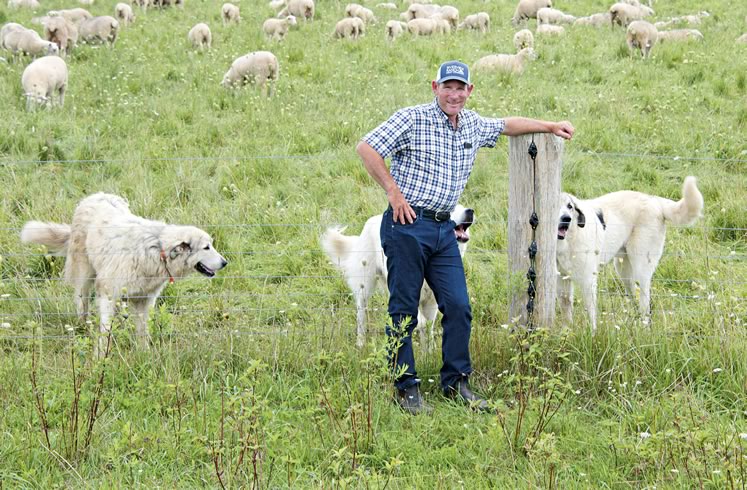
Sheep farmer and pasture manager Mike Swidersky with his capable canine assistants Penny, Leonardo and Willy-Jack. Photo by Pete Paterson.
As feeders of the populace and stewards of the land, today’s large-scale farmers must wear many hats, not just a weathered, sweat-stained ball cap to keep the sun off out in the fields.
They must satisfy a burgeoning metropolitan public’s insatiable demand for food, at the cheapest possible prices, and are subject to an equally voracious suburban development industry’s appetite for their farmlands.
They must dance with global corporations who supply them and whom they supply, compete with foreign food imports, manage their land toward a sustainable future while dealing with arduous here-and-now environmental rules and regulatory bodies – and make a living in a business notable both for staggering investments in land and equipment and for often razor-thin margins.
In advance of the annual Dufferin Farm Tour, on a balmy midafternoon when their fields were surely calling, Dufferin farmers Bert Tupling, Mike Swidersky and Darryl Burnett sat down with us for a roundtable discussion in the boardroom of Tupling Farms in Melancthon. At the last minute, Darryl joined the group by Zoom from the cab of his tractor. Both Mike and Darryl are featured in this fall’s farm tour video which launches October 2. Bert has participated in the past.
The Pandemic
Anthony Jenkins for In the Hills : First let me ask about the most recent challenge. How has the Covid-19 pandemic affected your market or the way you do business?
Bert Tupling : Sixty-five per cent of our potatoes go out to the food service sector; 35 per cent go to some type of retail. We have a contract that supplies Swiss Chalet and stores they’re associated with, like Kelsey’s and Montana’s for their fresh-cut french fries.
When the pandemic first happened, our sales switched: 65 per cent went to stores and retail, 35 per cent went to the food service sector. In the next year or so we switched back. Today, we’re back to where we were.
Mike Swidersky : Getting supplies, parts, it’s been more challenging, whether it’s hardware or machinery parts. You can’t just walk up to a counter and get stuff. As far as selling product, selling lambs, our lamb market has been outstanding. More people were wanting to cook from home, especially a luxury item like lamb.
Canadian lamb producers produce only 40 per cent of our market. Most of the food service and restaurants are serviced by imported lamb. When that stopped due to Covid, our market share actually increased.
AJ : Throughout the pandemic it seems people have been wanting to know where their food comes from and to support local businesses, especially smaller market garden farmers who sell direct to the consumer. Has that been a boon to local farmers?
MS : Bert’s a beef producer. If I buy beef, top-end steaks or roasts – whether it’s Bert’s or some of the other many beef producers in Dufferin – from Zehrs or any of the grocery stores, that’s local produce.
BT : As far as local is concerned, we did not see much change. In our operation, we produce beef for the domestic market, but also for the China market and for Japan and Great Britain. They all shut down. We didn’t have the transportation and the logistics to move that beef. Because of Covid-19, the workers didn’t show up some days. The packer didn’t know if he had people coming in to kill.
Technology
AJ : Has tech – drone, apps, GPS, social media and the like – changed your business?
MS : Absolutely. We farm because we can adapt to change. We adapt all the time whether it’s the weather, the pandemic. I did a two-year agriculture diploma at Guelph and I’m constantly learning from other people, via technology, social media. Our hands are so much closer to information now.
BT : As far as the tech side of it, there are those who still do it the old-fashioned way. But we’re among the top GPS users. We plant every row of potatoes within one inch of accuracy, which gives us a higher yield per acre.
AJ : Do you spend more time in the office than in the fields? Do you need to be tech and media savvy to be a successful farmer nowadays? Do you need a post-secondary education?
MS : I’m still spending more time in the fields. The office comes to the field. With the use of a mobile phone I don’t have to go to the house to have a meeting. Darryl is here via Zoom. That’s a regular occurrence now.
Darryl Burnett : We do use a tremendous amount of technology on the farm. Everybody wants to be more efficient. I’m sitting in a tractor seat right now. I’m almost always in my pickup. My pickup is my office.
BT : I’ve got grandsons who I am encouraging to go to schools and learn. But learning where to find out about things is just as important. If you listened to the radio this morning, you heard there’s three new grassy weeds causing problems with the wheat. We know we’ve got a problem. We need to know where to go and find out how to control them.
DB : My dad didn’t finish high school. He always thought that made it much more challenging through his farming career. My parents strongly encouraged me to further my education. I went to the University of Guelph and graduated with a bachelor of science degree. Business was my secondary. These are all businesses we have. Mike is in lambing and livestock agriculture, Bert is in potato and beef and grain farming, but we can all sit down at the table here and all learn something from each other.
Like-minded people tend to be around like-minded people. It might be a neighbour across the road. It might be someone that’s in Saskatchewan, or around the world. That’s where technology gets us. But you can’t rely solely on tech. It comes down to work, effort and ability, good business sense, and a good bit of luck.
Land Loss
AJ : Based on census figures, the Ontario Federation of Agriculture says that for the past two decades, the province has lost 175 acres of farmland every day. Are the effects of population growth and development affecting you in Dufferin County?
BT : Yes. People are coming here to live because they can’t afford housing in Toronto. The little hamlet of Honeywood is now full of “bed” people who have to leave at 5 o’clock in the morning, be at work in Toronto at 7. They leave Toronto at 5 o’clock and get home at 7 at night, grab something to eat and go to bed.
It’s affecting us. These young people are going to have a family. Where are they going to have support from, to keep kids off the street, keep them occupied and not causing trouble? We need a new arena in Honeywood.
MS : As rural people we’re pretty self-sufficient. We don’t need someone picking up our garbage. We don’t have to worry about compost. We don’t mind driving on roads with some snow on them. People who move up have quite different expectations.
BT : It’s a well-known fact in this area a whole farm in 2002 could have been bought for $250,000. A one-acre lot off that farm now sells for $250,000. That leaves a 99-acre farm. Now we’ve got a conflict of interest between whatever the person wants to do on that one acre and a farmer with a field of potatoes that has to be sprayed every five days. We’re being affected by the urbanite who wants to come and live next door to a farm. They come, but they want us to abide by their rules and regulations.
DB : I sit on the board of the Dufferin County Agricultural Advisory Group. Traffic is a huge issue. The roads weren’t built for the amount of traffic we have on them now and there are risks moving heavy equipment around. Three years ago we’d pull up with farm machinery to Highway 9 from one of our back roads at 5 o’clock in the morning and basically pull out on the road knowing that there’s no cars coming. We literally wait two or three minutes at that time in the morning now, for traffic.
We’re in the south of Dufferin County. We’ve lost multiple farms we were renting at the time to urban sprawl. I’d rather have development in the towns, but it does add challenges. For example, there are distance requirements when you’re building livestock barns or different facilities. That all adds to costs. It does increase the value of the land substantially, though. As house prices go up, as land prices go up…
AJ : As house prices go up, are you tempted to sell off, take a big pay day and head to retirement?
DB : That’s everybody’s option. We want to be in the business of agriculture. I’d love my kids to be, if they choose. What’s the average age of the Ontario farmer right now? It’s got to be encroaching on 60 years old. Lots of farmers will still work. My dad’s 75; he’s still active on the farm every day because that’s what he loves to do.
AJ : Is loss of farmland a problem and, if so, what can be done?
MS : In local politics in Dufferin County, the municipalities with the most clout are the ones with the highest populations – Orangeville, Shelburne, Mono. If you asked them all, I’m sure they’d all say saving the farmland is important – until it comes to the dollars and cents of building subdivisions.
DB : If there’s 300,000 new Canadians that immigrate to the country this year, I honestly think they’d be better served being where the jobs are, close to metropolitan centres. That being said, we have several “new Canadian” landowners we work with from many parts of the world, and most are much closer to their food and awareness of agriculture in general than the average population.
But the land is so expensive. When the Greenbelt was implemented around the GTA, public policy said farmland should be preserved, you’re not allowed to change that to residential.
If it’s public policy that agricultural land is to be protected, that it’s going to be green space, and you are restricted to who you can sell it to as a farm landowner, then the public taxpayer should help pay for that.
I personally think that most of the Greenbelt, other than the very protected conservation lands, is where most of the housing should be built. They have the infrastructure, they have the roads. There’s 14 million taxpayers that can pay for a 407 highway.
That’s what public policy did. It’s shifted these million-dollar homes in Toronto, so now they’re trading for $800,000 in the hamlet of Grand Valley and up in Honeywood, as Bert says. Our roads and infrastructure just will not cope. Someone’s going to have to bear the cost. If it’s for the greater good, it shouldn’t be the farmer, the agricultural landowner, to bear. It happens too often.
The Environment
AJ : The Dufferin Federation of Agriculture calls farmers “stewards of the land,” yet farming practices such as the use of pesticides and chemical fertilizers, GMOs, monocultures are blamed for contributing to climate change. Are those charges fair?
MS : Most of what you call environmental goods and services, that’s how we stay in business. We increase our organic matter. We use the least amounts of pesticides and inputs possible. If we use less and get the same results, that’s better for us economically. We are the environmental groups. Absolutely! We’re paying a lot more for our fuel because of the carbon tax even though we are sequestering carbon! I’d prefer if the government would just keep their hands off.
DB : In our operation, two-thirds of our acres are planted with genetically modified seed. A hundred per cent by our personal business choice. And on our land after winter wheat is harvested, we integrate cover crops, we integrate animal grazing where we can on these covers. Last year we grew a beautiful cover crop of red clover and oats after wheat harvest that a neighbouring beef farmer grazed his cow-calf herd on through the fall. What a perfect nutrient cycle that made by not fighting nature but fostering it. It’s these sorts of bridges farmers make to help each other and the environment.
I’m the past president of the Innovative Farmers Association of Ontario. IFAO is entirely dedicated to soil health, cover crops and water quality. Our grain operation is probably slightly larger than the average grain farm in Dufferin County, but that doesn’t mean we overlook any small details – quite the opposite. We have technology on our planters, sprayers and drills that almost never puts two seeds in the same spot. It’s all GPS controlled to adjust for overlaps and double applications, etc. Our sprayers, our fertilizers, every pesticide we spray, where our sprayers go, where our tractors go – I know on my phone, every detail, including how much fuel each of our combines is using in gallons per hour per acre, and it’s all livestreamed right to my handheld.
It’s more environmentally friendly. We have less waste. We have the capacity to do this. Canadian farmers can solve so much related to climate change through carbon sequestration and we’ve never even been invited to the table by the Canadian government. Never.
AJ : Why is that?
DB : Because we’re 2 per cent…
MS : … 2 per cent of the population. We mean nothing to the politicians.
In the last year I cannot tell you when I didn’t have either a bird scientist, a bee scientist, somebody tracing mosquito disease, whether a private company or academia, doing a study on our farm. My compensation has been zero dollars. We volunteer. These are things people don’t know.
AJ : There are a great many environmental regulations on farmers. Are they onerous? Are all the rules and regulatory bodies necessary?
BT : I don’t necessarily say they are necessary, but I have come to the place where I accept them as being part of doing business. We’ve got to work with them. They’re not there to help us.
We are controlled by CanadaGAP [Good Agricultural Practices for fruits and vegetables]. We have to be certified every year or we can’t sell a bag of potatoes. An inspector comes in, watches us dig potatoes, watches us pack potatoes, stands and watches and looks at all of the things that go on in our pack house. I can’t sell potatoes if I haven’t got a CanadaGAP certificate.
DB : Twenty-five years ago there were probably five abattoirs processing local beef and lambs. Government legislation has made it so difficult at the livestock processing facilities that they basically shut down every abattoir Dufferin had.
They have to have so many inspectors and it’s so onerous. The federal government, through legislation, has pushed them so far, the plants have to be so large to be able to afford compliance and all the updates.
The challenge is when you have countries that don’t have the same regulations. Our best management practices are so tight. Everybody knows that.
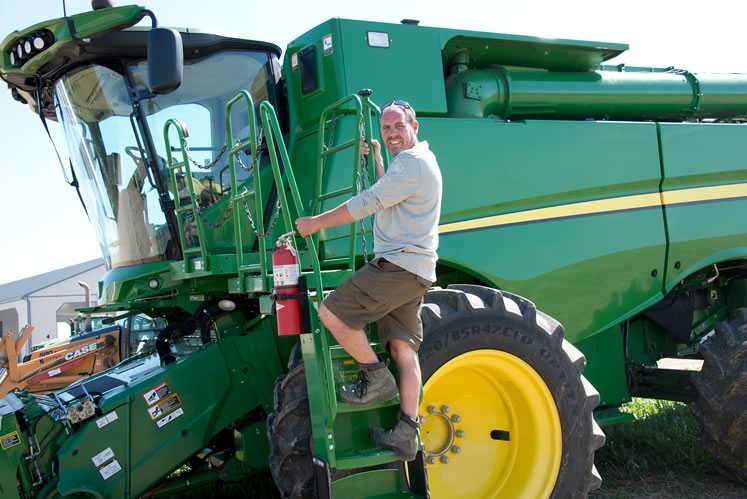
Grain farmer Darryl Burnett climbs aboard a massive John Deere harvester at his farm in East Garafraxa. Photo by Pete Paterson.
AJ : With the regulations concerning food production in Canada being more arduous, are our farmers competing globally on an uneven playing field?
BT : Without any question. There could be potatoes coming from Idaho – we think we’re good friends with the United States – and they don’t go through the CanadaGAP situation that we do. Every potato grown on this farm, every acre, I can document what field it was grown on, what fertilizer, what manure.
DB : We have enough legislation in place that if there ever is a problem, they have traceability. We have pigs at home. Through the Canadian Quality Assurance program and other similar programs, every pig, lamb, chicken or cow is traced and detailed from birth to processing. The traceability on Mike’s lambs, the legislation is there. I think the farming community does a fantastic, an A-1 job. We’re not very good at patting ourselves on the back. When somebody isn’t in compliance, we do a friendly neighbourhood gesture saying, “Hey, this would make sense…” We’re very good at self-regulating. Do we need more regulation? Absolutely not.
AJ : Well, say your counterpart in Idaho or China doesn’t do that, saving costs. What can be done to alleviate that competitive disadvantage?
BT : Educate the consumer about what she’s buying. She’s not buying by the penny. She’s buying by quality. I’d like to say to the consumer, “Would you please verify where that product comes from? If you have to have it, go ahead and buy it, but here’s a local product that we feel is superior – and pay me accordingly.”
AJ : That seems a big ask. I see a bag of potatoes, I throw it in the shopping cart. I’m not reading the fine print. How do you educate people like me?
BT : That’s what we’re doing right here today.
MS : I don’t understand how you could walk by and not look at the label on a bag of potatoes. That’s bizarre to me.
The Agri-Food Chain
AJ : The global agri-food industry is dominated by huge multinational corporations across energy/chemical/machinery/seed/processing/packing/retailing and restaurant chains. Where does the farmer fit in?
BT : What caused the big corporations was economics. Why did Pioneer buy out Syngenta? Or why did Bayer buy part of Monsanto? So that they could corner more of the market.
Even though they are not supposed to, the fertilizer companies get together and they know what potash is going to come from Russia, what it’s going to cost versus what they can get it produced out of Saskatchewan for. The same thing with chemicals. They know what chemical is going to be put together in Iran, shipped to the United States and then shipped to Canada. Then the first thing they tell you is, “It’s getting in short supply.”
DB : The farmer is still the hub of the agri-food industry. Unfortunately we’re in a situation where we have to buy our inputs retail and sell our product wholesale. If we don’t protect the farmers, even more so than farmland itself, we can have 25 million arable acres across Canada to farm, but who’s going to do it? When you talk about national food security – that’s huge.
AJ : You used the phrase “protect the farmer.” How do we do that?
DB : Have some support programs. For 30 years Canada has had a tremendous cheap food policy.
We’re spending a million dollars on our house and we’re spending about 9 to 13 per cent of our disposable income on food. People complain more about the price of food going up, the price of potatoes and the price of lamb, than they do about the price of their house. My grandpa said it’s fantastic. He said there’s three generations of Canadians who don’t know what it’s like to go without food. But that has made Canadian consumers complacent, in my opinion.
Even through this pandemic the scare was for toilet paper. We’re in a First World society. When we can’t get what we want, when we want it, it’s chaos.
MS : I don’t know that protecting farmers is a whole lot different than protecting any business in Canada. Have policies in place that don’t limit our competitiveness. Right from the municipal level, we have expensive red tape, whether it’s from putting in a wider driveway for farm machinery to building permits to a carbon tax.
DB : Farmers are tremendously innovative. They will diversify and they will change, but don’t make it so onerous. We’re already at the top as far as all our quality assurances. We don’t need more regulations. The door is open for other countries to export at the lowest possible price. That’s the challenge right now. There isn’t the same stringent quality assurances on things coming in from other countries.
The Public’s Perception
AJ : Promotional videos for the Dufferin Farm Tour show happy farmers, bucolic charm, the joys of new technology, but little sweat or toil. Does the public have an unrealistic, romanticized view of farmers?
DB : I don’t think anything is skewed drastically. Those are real farms. When you come to a dairy, beef or grain farm, that farm is in its work clothes, though they might have pressure washed the tractor that morning, mowed the lawn, cleaned things up a bit. People visiting are seeing working farms – the cows were still milked there that morning.
MS : We are our own bosses. We’re probably doing the job we wanted to do since we were little kids. We’re the ones who, when we see a white-tailed deer cross our fields, we stop and look. We enjoy that. Or birds. I know farmers who for generations have tracked the day the barn swallows come and go in their barns.
The welfare of our animals is important to us. If something is sick, we take care of it before we eat or go to bed. Those happy people on the farm tour videos, they are who we are.
AJ : What do you wish the public knew, or better understood, about what you do?
BT : What we do to be able to sell our products. You can sell stuff back door or on a food stand. Are you compliant? The public needs to know all the little things that we do that come at an added cost to us, the farmers, but not necessarily an added cost to the consumer.
DB : Nobody is nostalgic for 1940s dentistry or 1950s cancer treatment, but everybody seems to be nostalgic for 1950s food production. They have a huge skew on food production: “If it’s done on a large scale, then you must be doing something wrong.”
Nobody wants the AstraZeneca vaccine because it’s not good enough. What everybody wants is the Pfizer vaccine. That is a genetically modified vaccination. They want the best of the best science. Why wouldn’t we use the best of the best science to feed the 7 billion people on this planet?
I’ve got friends who are organic farmers. I am 1000 per cent in favour of organic farm production if that’s the farmer’s choice and it puts dollars in his or her pocket. But it’s normally practised on much smaller acreages, with an often larger workload, that is not sustainable to feed the expanding world population.
MS : As farmers, we are making our farms better. That includes having animal habitat, bird habitat, making our farms better for the next generation. We’re concerned about the environment. We’re concerned about animal welfare.
AJ : All this in addition to making a living?
MS : Yeah, because those things are important if we want to continue. They’re not an afterthought. It is something we’re always looking at. I’m trying to get more organic matter so I have better water holding capacity in dry weather and I’m able to use less fertilizer. Because of that my yields are better, my animals are healthier, and hopefully I’m more profitable.
On Earth Day, people say, “I recycle!” Yeah, what do you do after that? And where does your recycling go?
We buy 700-plus tonnes of compost a year. They think they’re being super environmental by composting, but they don’t know where that goes. The loop does not close. Livestock farmers are feeding their herds by-products from our wheat. Quite often food waste goes back into animal feed or fertilizer. The circle goes beyond the table.
Dufferin Farm Tour
Every fall since 2000, Headwaters residents have been invited on the Dufferin Farm Tour, an up-close, self-guided look at local agriculture. However, as the Covid-19 pandemic drags on, this year’s tour will be virtual. The half-hour video will showcase the diversity of agriculture in a county where farmers are owners and stewards of 48 per cent of the land.
The tour launches with a watch party on October 2 at 7 p.m., and will continue to be available for viewing after that at dufferinfarmtour.com.
Related Stories
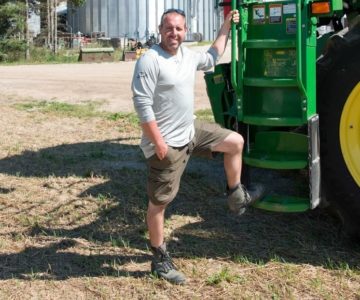
Meet the Farmers
Sep 24, 2021 | | FarmingBert Tupling, Mike Swidersky and Darryl Burnett criss-cross Dufferin County tending to wheat, barley, corn, potatoes, cattle, sheep and more.
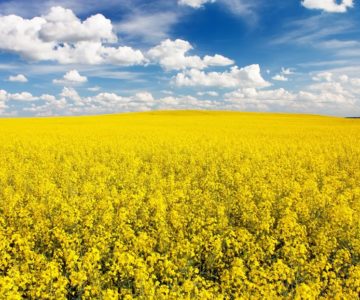
An Exurbanite’s Guide to Field Crops
Sep 24, 2021 | | FarmingA drive-by primer on what’s growing in Headwaters.
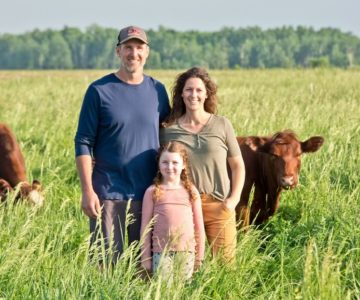
Regenerative Agriculture Puts the Soil First
Jun 22, 2021 | | FarmingHow cover crops, crop rotation and using livestock to fertilize fields puts local farmers on the front lines in reducing climate change.
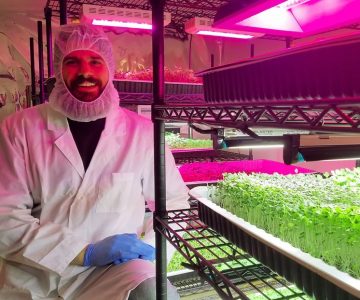
Microgreens Go Macro
Mar 24, 2020 | | FarmingHow local growers are tapping a surging demand for the tiny, tasty stems that pack a nutritional punch.

Sunflower and Lavender Dreams
Jun 22, 2021 | | FarmingLocal sunflower and lavender farms are bursting with some of nature’s showiest blooms. Here’s how to enjoy them in person and via handmade products that capture the magic.
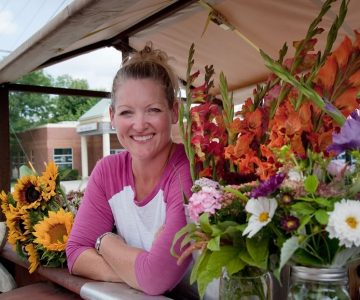
The Florist Farmer: Petals Flower Co.
Mar 19, 2019 | | FarmingMelanthon’s Amber Swidersky creates lush bouquets with blooms just steps from her floral studio.








